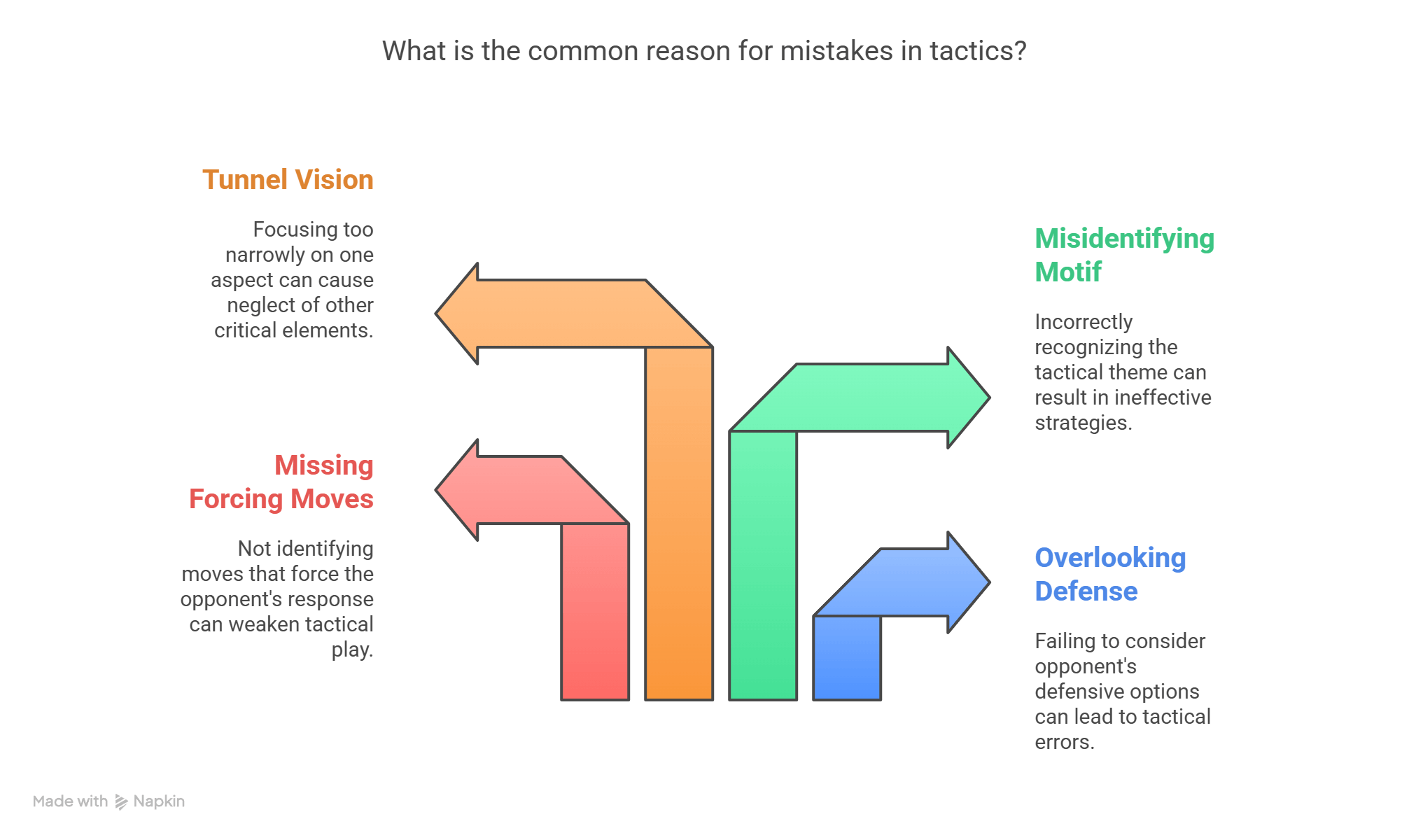Introduction
If you’re looking for a fast and effective way to improve your chess skills, focusing on tactics is one of the smartest choices you can make. Tactics are short-term combinations that can win material or deliver checkmate, and recognizing them quickly can dramatically change the course of your games. Whether you’re a beginner or an experienced player, improving chess tactics leads to noticeable results in a short time.
In this article, you’ll discover five actionable methods that will help you learn and improve your tactical skills. By following these steps consistently, you’ll develop sharper calculation, better pattern recognition, and a stronger overall understanding of the game. Let’s learn how to improve chess tactics.

1. Learn Basic Tactical Motifs
Before you can spot winning tactics in your games, you need to understand the basic building blocks: tactical motifs. These are recurring patterns that show up in all levels of chess, from beginner games to grandmaster battles. Recognizing these motifs will allow you to find opportunities that others might miss.
Here are some of the most essential tactical motifs to master:
- Double Attacks: A single piece attacks two or more targets at once, often forcing a material gain.
- Pins: An attacked piece cannot move without exposing a more valuable piece behind it, making it vulnerable.
- Skewers: Similar to pins, but in this case, the more valuable piece is attacked first and must move, exposing a lesser piece behind it.
- Discovered Attacks: Moving one piece reveals a hidden attack from another, often leading to a devastating blow.
- Removing the Defender: Capturing or neutralizing a piece that is guarding an important square or another piece.
These are just some of the basic tactical patterns every chess player should know. However, there are many more motifs that are equally important to understand and master. A solid understanding of these motifs forms the foundation for all tactical training. If you’re serious about sharpening your tactical skills, feel free to contact me for guidance or explore the recommended resources listed below.
- 1001 Chess Exercises for Beginners by Franco Masetti
- Winning Chess Tactics by Yasser Seirawan
- Chess Tactics for Champions by Susan Polgar
- Chess Tactics from Scratch: Understanding Chess Tactics by Martin Weteschnik
- 1001 Chess Exercises for Club Players by Frank Erwich
The books listed above offer focused practice, allowing you to learn and concentrate on one tactical motif at a time.
2. Solve Puzzles on a Specific Tactical Motif
Once you’ve learned the basic tactical motifs, the next step is focused practice. Instead of jumping into random puzzles, concentrate on one motif at a time. For example, spend a session only solving puzzles that feature forks, then move on to puzzles about pins, and so on.
This targeted approach helps you build quicker recognition. By repeatedly seeing the same type of pattern, your brain learns to spot it almost automatically. Over time, you’ll develop an instinct for recognizing specific tactical opportunities the moment they arise in your games, without needing to consciously search for them.
3. Solve Puzzles on Various Tactical Motifs
After you feel confident with individual motifs, it’s important to mix things up. Solve puzzles that combine different tactical themes – forks, pins, discovered attacks, and more – without knowing in advance which motif you need to find.
Practicing with mixed-motif puzzles is valuable because it simulates real-game conditions. In a real game, you won’t be told that a fork or pin exists – you’ll have to spot the opportunity yourself. Regular exposure to a variety of tactics sharpens your pattern recognition and trains you to think more flexibly during games, ultimately making your tactical vision much stronger.
There are excellent online platforms that offer a wide range of puzzles featuring various tactical motifs. Websites like Lichess, Chess.com, and ChessTempo provide interactive puzzles that challenge your pattern recognition with mixed-motif exercises. These resources allow you to practice at different levels of difficulty, making it easy to track your progress and improve your tactical abilities.
4. Understand Your Mistakes
Improving tactics isn’t just about solving lots of puzzles – it’s about learning from your mistakes. Every time you get a puzzle wrong, take a moment to carefully review it. Try to understand why your solution failed before moving on.
Common reasons for mistakes include:
- Overlooking defensive resources: You might find an idea that looks good but miss how your opponent can defend.
- Missing forcing moves: Checks, captures, and threats often hold the key to tactics, and missing them can cause you to overlook the solution.
- Misidentifying the motif: Sometimes you recognize that a tactic exists, but you choose the wrong one for the position.
- Tunnel vision: Focusing too narrowly on your own plans without considering your opponent’s threats.

By identifying the specific reason you missed a tactic, you turn each mistake into a powerful learning opportunity that sharpens your tactical awareness for future games.
5. Practice Regularly
When it comes to mastering chess tactics, consistency beats intensity. It’s far more effective to practice tactics a little each day than to cram in long sessions once in a while.
Here are a few tips for building a strong practice habit:
- Set a daily goal: Even solving 5–10 puzzles each day can lead to significant improvement over time.
- Gradually increase difficulty: As you get faster and more accurate, challenge yourself with harder puzzles.
- Track your progress: Seeing your puzzle rating or success rate climb can be a great motivator.
Daily, focused practice steadily builds the pattern recognition and calculation skills you need to spot tactical opportunities instinctively in your games.
How to Improve Chess Tactics: Final Thoughts
Improving your tactical skills is one of the quickest ways to become a stronger chess player, but it requires a structured and deliberate approach. By learning basic motifs, practicing focused and mixed puzzles, reviewing your mistakes, and maintaining a regular training habit, you create a system that steadily sharpens your ability to find winning combinations.
Consistency is key. If you apply these five methods with dedication, you’ll not only start spotting tactics faster – you’ll build lasting skills that will significantly elevate your overall play.
FAQ
1. How long should I practice tactics each day to see improvement?
Just 10-20 minutes of focused daily practice can lead to noticeable improvement within weeks. The key is consistency and gradually increasing the difficulty as you progress.
2. What’s the best way to start if I’m new to tactics?
Start by learning the most common tactical motifs like forks, pins, skewers, and discovered attacks. Use beginner-friendly books or puzzle sets that focus on one motif at a time.
3. How do I know which tactical motif a puzzle is using?
When you’re starting out, it’s helpful to use themed puzzles that tell you the motif. As you improve, try solving mixed puzzles without hints to develop real-game recognition skills.
4. What should I do when I keep getting puzzles wrong?
Take time to analyze your mistakes. Look for patterns in the types of errors you’re making – like tunnel vision or overlooking defensive moves – and focus on improving those areas.
5. Can solving tactics help me even if I don’t play often?
Yes! Tactics sharpen your calculation and pattern recognition, which are useful whenever you do play. Plus, even occasional puzzle-solving helps keep your chess instincts sharp.
